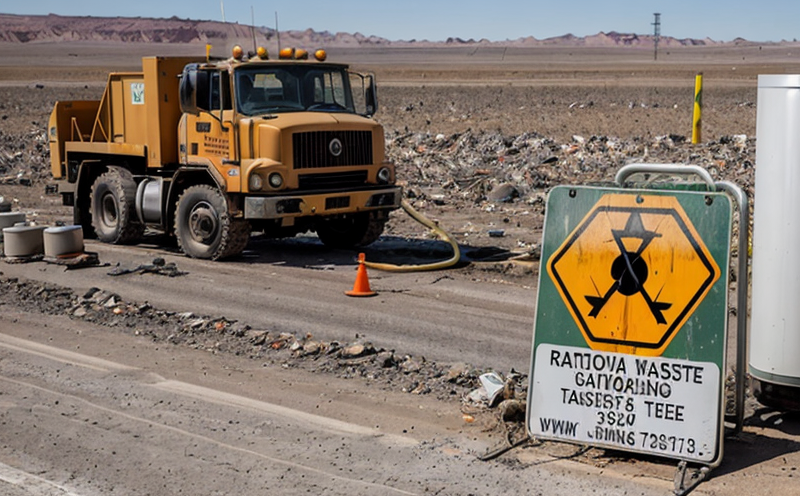ISO 11665-7 Radon Exhalation Testing from Waste Packages
The International Organization for Standardization (ISO) has established a standard known as ISO 11665-7, which provides the methodology for measuring radon exhalation from waste packages containing radioactive materials. This service is critical in ensuring compliance with regulatory requirements and safety standards, particularly relevant to sectors such as nuclear power generation, defense, and environmental protection.
The standard specifies a procedure that aims to quantify the amount of radon gas released by waste packages over time under controlled conditions. Radon exhalation testing plays a crucial role in assessing the potential for radon release during transport, storage, or disposal of radioactive materials. This service is essential for ensuring public and environmental safety.
The ISO 11665-7 method involves placing waste packages into a specially designed chamber where the temperature and pressure are controlled to simulate real-world conditions. The chamber then monitors the rate at which radon gas escapes from the material. By measuring this rate, laboratories can determine whether the waste package meets regulatory limits for radon release.
The testing process begins with detailed preparation of the specimen. This includes ensuring that the waste package is stable and secure within the test chamber to prevent any external interference during the measurement period. The package must also be preconditioned to ensure accurate results by equilibrating its internal environment to match the conditions in which it will be transported or stored.
Once prepared, the specimen is placed into a sealed chamber where radon levels are measured over time. A variety of instruments and techniques may be used for this purpose, including mass spectrometry and alpha spectrometry. The testing period can vary depending on the type of waste package but typically lasts several days to ensure accurate measurements.
The results from these tests are then analyzed using statistical methods to determine compliance with relevant regulations. Compliance officers will use these data points to make informed decisions regarding the handling, transport, and disposal of radioactive materials. Quality managers rely on this information to ensure that all processes adhere strictly to industry best practices.
In addition to regulatory compliance, ISO 11665-7 radon exhalation testing provides valuable insights into the potential risks associated with specific waste packages. By identifying high-radon-emitting materials early in the process, stakeholders can implement preventive measures to mitigate these risks effectively.
The accuracy and reliability of the test results are paramount to this service. Laboratories must adhere strictly to ISO 11665-7 guidelines during all phases of specimen preparation, testing, and analysis. Rigorous quality control procedures ensure that each measurement is precise and consistent with previous tests conducted under similar conditions.
Accurate radon exhalation testing also facilitates better decision-making regarding the safe handling and disposal of radioactive waste packages. With reliable data at their fingertips, stakeholders can prioritize resources towards managing higher-risk materials more effectively.
Quality and Reliability Assurance
The quality and reliability assurance processes in ISO 11665-7 testing are critical to ensuring accurate results that meet regulatory requirements. Laboratories must implement robust quality control measures throughout the entire testing process, from specimen preparation to final analysis.
- Specimen Preparation: Ensuring specimens are properly prepared and preconditioned is essential for obtaining reliable test results. Specimens should be free from contamination or external influences that could affect the measurement of radon gas.
- Instrument Calibration: All instruments used in ISO 11665-7 testing must be regularly calibrated to ensure accuracy. This includes checking mass spectrometers and alpha spectrometers for optimal performance before each test run.
- Data Analysis: Data collected during the testing process should undergo thorough analysis using statistical methods. Any anomalies or inconsistencies in the data need to be investigated promptly to maintain integrity of the results.
Regular internal audits and external accreditation reviews help maintain high standards within the laboratory environment, ensuring continuous improvement and adherence to best practices.
International Acceptance and Recognition
The ISO 11665-7 standard for radon exhalation testing has gained widespread acceptance across various international regulatory bodies. This ensures that results obtained from accredited laboratories are recognized globally, enhancing trust and facilitating cross-border collaboration.
| Regulatory Body | Acknowledgment Status | Relevant Standards |
|---|---|---|
| Nuclear Regulatory Commission (NRC) | Recognized for compliance testing | ISO 11665-7 |
| International Atomic Energy Agency (IAEA) | Recommended practice | IAEA Technical Documents |
| European Commission | Compliant with EU directives on radioactive waste management | Directive 2011/70/EU |
The widespread recognition of this standard reflects its importance in ensuring consistent and reliable testing across different jurisdictions. By adhering to ISO 11665-7, laboratories demonstrate their commitment to maintaining high standards of quality and reliability.





